前言
本文使用的模型是阿里云百炼的模型 直通阿里云百炼Function Calling
要求: 需要的为nodejs 做服务器 、会基础的sse(不会也没事,会cv就完了)
记得自己配一下apiKey~
简介
AI 根据任务需求 主动触发对外部工具/服务/代码逻辑的调用
Function Call 的核心逻辑不是AI自己执行函数,而是:
- 判断是否需要调用:AI 先分析用户需求 ------ 如果靠自身知识库能回答(比如 "地球半径多少"),就不调用;如果需要外部数据 / 操作(比如 "实时股票价格"),就决定调用。
- 正确构造函数参数: AI 需要按照外部函数的格式要求,自动填充参数(比如调用天气API的时候,正确传入"城市","日期",避免参数缺失)
- 处理返回结果:外部函数返回数据后,AI需要理解结果并转化为用户能懂的自然语言(而不是直接丢出API原始响应)
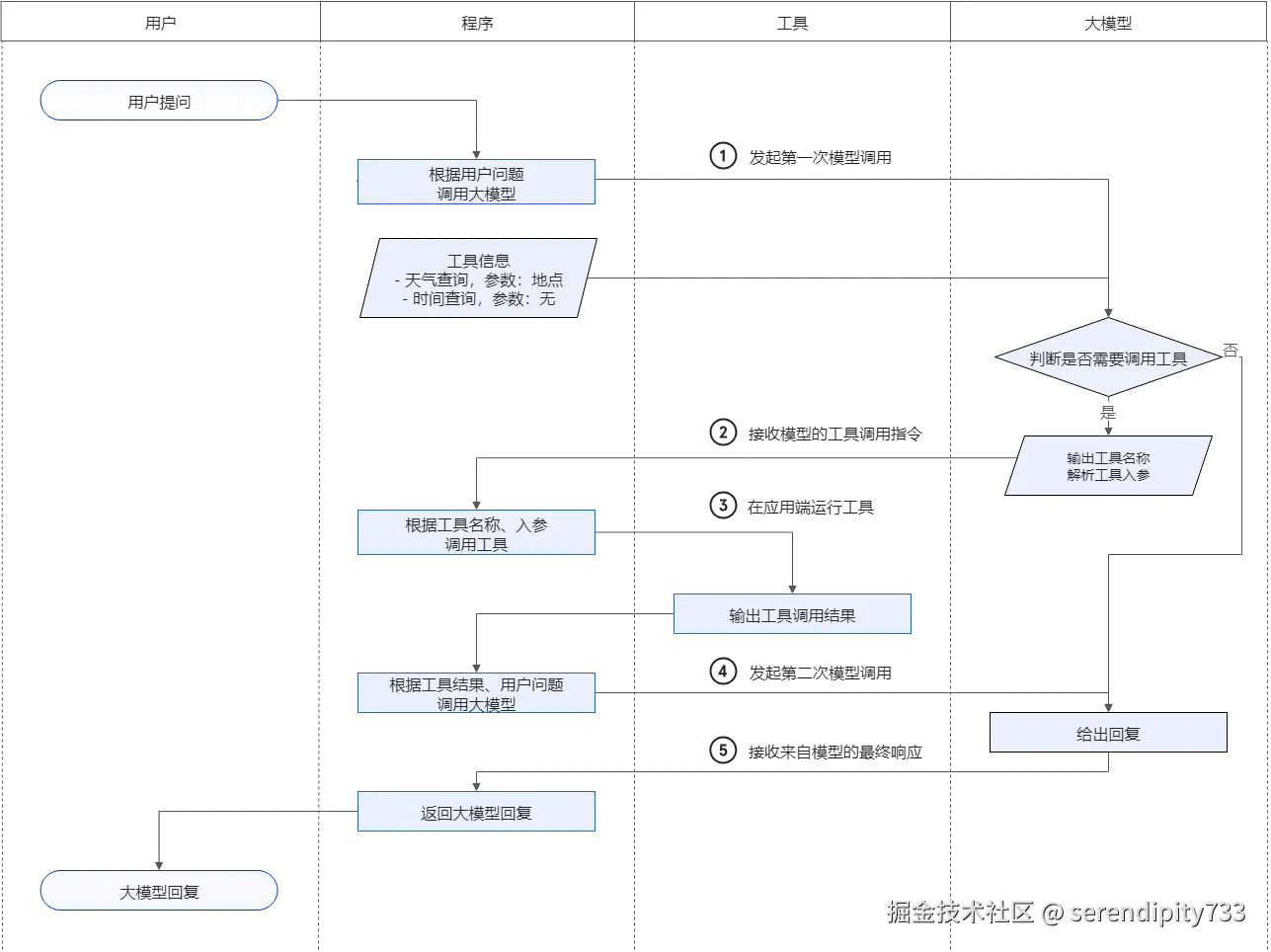
预备函数
js
// 工具执行映射
export const toolExecutors = {
get_current_weather: getCurrentWeather,
// 未来可以添加更多工具
// get_stock_price: getStockPrice,
// search_web: searchWeb,
};
// 执行工具函数
export const executeTool = (functionName, args) => {
const executor = toolExecutors[functionName];
if (!executor) {
throw new Error(`未找到工具: ${functionName}`);
}
return executor(args);
};
js
router.post("/stream", async (req, res) => {
console.log(req.body, "req.body");
try {
const {
message,
model = "qwen-plus",
sessionId = null,
systemPrompt = null,
} = req.body;
if (!message) {
return res.status(400).json({ error: "message 参数不能为空" });
}
// 设置 SSE 头
res.setHeader("Content-Type", "text/event-stream");
res.setHeader("Cache-Control", "no-cache");
res.setHeader("Connection", "keep-alive");
res.flushHeaders();
await streamChatWithTools(message, model, {
onToken: (delta) => {
console.log(delta, "token delta");
//给前端逐字发送消息
res.write(
`data: ${JSON.stringify({ type: "token", content: delta })}\n\n`
);
},
onToolCall: (name, args, result) => {
console.log({ name, args, result }, "tool delta");
res.write(
`data: ${JSON.stringify({ type: "tool", name, args, result })}\n\n`
);
},
onDone: ({ sessionId: sid, stats }) => {
console.log("onDone");
res.write(
`data: ${JSON.stringify({ type: "done", sessionId: sid, stats })}\n\n`
);
res.end();
},
onError: (error) => {
res.write(
`data: ${JSON.stringify({
type: "error",
message: error.message,
})}\n\n`
);
res.end();
},
sessionId,
systemPrompt,
});
} catch (error) {
console.error("❌ 工具流式聊天错误:", error);
if (!res.headersSent) {
res.status(500).json({
success: false,
error: error.message || "服务器内部错误",
});
}
}
});初步使用function call(非流式)
定义工具
js
export const weatherTool = {
type: "function",
function: {
name: "get_current_weather",
description: "当你想查询指定城市的天气时非常有用。",
parameters: {
type: "object",
properties: {
location: {
type: "string",
description: "城市或县区,比如北京市、杭州市、余杭区等。",
},
},
required: ["location"],
},
},
};注意:使用的时候是一个tools数组 export const tools = [weatherTool];
创建聊天函数
js
export const chatWithTools = async (userMessage, model = "qwen-plus") => {
//1.-----------------------------发起请求--------------------------------
const messages = [
{
role: "user",
content: userMessage,
},
];
//模型返回
let response = await openai.chat.completions.create({
model,
messages,
tools,//工具数组
});
let assistantMessage = response.choices[0].message;
//2.-------------------------判断是否需要工具----------------------------
//
// 确保 AI 回复不是null
//// 兜底:如果 content 是 null,置为空字符串
if (!assistantMessage.content) {
assistantMessage.content = "";
}
// 把模型的回复加入对话历史
messages.push(assistantMessage);
// 判断:模型有没有要求调用工具?
if (!assistantMessage.tool_calls) {
console.log(`无需调用天气查询工具,直接回复:${assistantMessage.content}`);
return {
needToolCall: false,
finalResponse: assistantMessage.content,
messages,
};
}
//3 --------------------执行工具-------------------------------------
// 工具调用循环
const toolCallLogs = []; // 记录所有工具日志
while (assistantMessage.tool_calls) {
// 取第一个工具 因为现在只能调用一个 不支持多个
const toolCall = assistantMessage.tool_calls[0];
const toolCallId = toolCall.id; // "call_abc123"
const funcName = toolCall.function.name; // "get_current_weather"
const funcArgs = JSON.parse(toolCall.function.arguments); // { location: "北京" }
console.log(`🔧 正在调用工具 [${funcName}],参数:`, funcArgs);
// 执行工具函数(下方给) 返回:"北京今天是晴天,温度25°C。"
const toolResult = await executeTool(funcName, funcArgs);
// 记录日志
toolCallLogs.push({
tool: funcName,
args: funcArgs,
result: toolResult,
});
// 构造工具返回消息(符合 OpenAI 规范)
const toolMessage = {
role: "tool",
tool_call_id: toolCallId, // 必须对应上面的 id
content: toolResult, // 工具执行结果
};
console.log(`工具返回:${toolMessage.content}`);
// 把工具结果加入对话历史
messages.push(toolMessage);
// 4. ----------------------模型总结成自然语言-----------------------------
response = await openai.chat.completions.create({
model,
messages,
tools,
});
assistantMessage = response.choices[0].message;
// 兜底
if (!assistantMessage.content) {
assistantMessage.content = "";
}
// 把模型的总结加入对话历史
messages.push(assistantMessage);
}
console.log(`助手最终回复:${assistantMessage.content}`);
return {
needToolCall: true,
finalResponse: assistantMessage.content,
toolCallLogs,
messages,
};
};代码逻辑(注释有讲解,数字对应每个步骤)
1. 发起请求
创建用户信息,发起请求
模型返回 数据格式如下:
js
{
choices: [{
message: {
role: "assistant",
content: null, // 没有文本内容
tool_calls: [ // 决定调用工具
{
id: "call_abc123",
type: "function",
function: {
name: "get_current_weather",
arguments: '{"location":"北京"}' // 完整的 JSON 字符串
}
}
]
}
}]
}2.是否需要工具
执行后的message状态
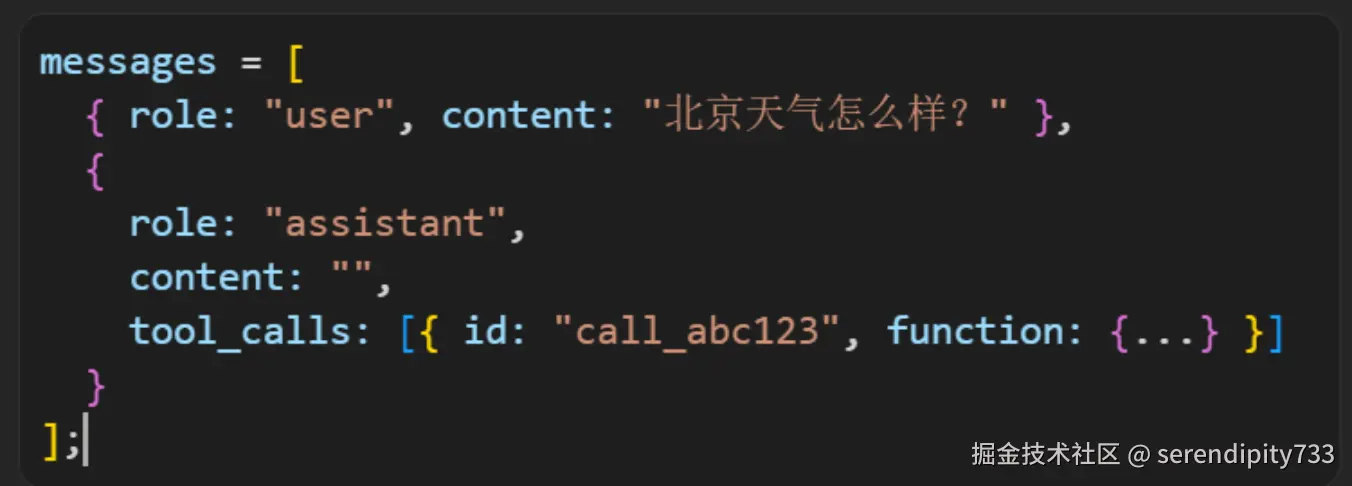
3. 执行工具
message状态
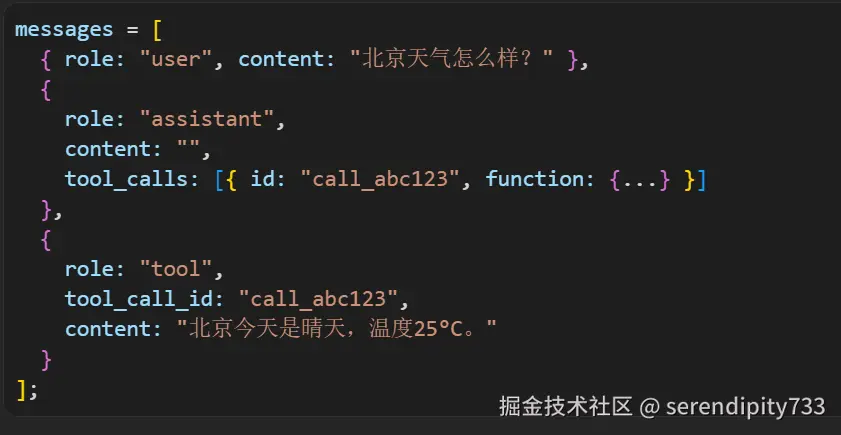
4.模型总结
执行后的模型返回的repsonse结果
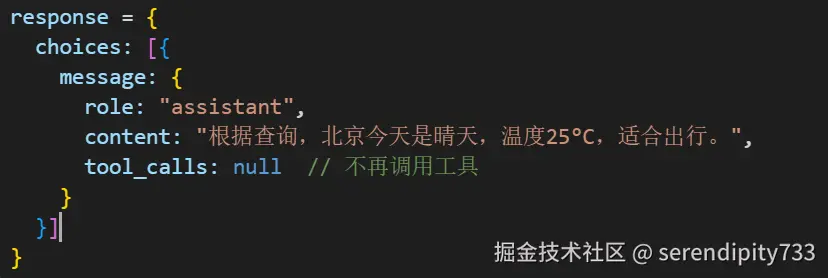
此时message的最终形态

代码解惑
- 为什么要确保content不是null
因为在"function call" 的场景下 模型返回的assisant 通常只有tool_calls(或function_call),规范允许省略文本内容,此时message.content 可能是null/undefined,
如果后续: 把这条消息直接messages.push(assistantOutput)再继续对话或在日志/前端 里做字符串,渲染文都可能因为content 为空而报错 或显示异常。
- tool_call_id 的作用
模型返回的每个工具调用都有唯一 ID,工具结果必须带上对应的 ID,模型才能匹配"这是哪个工具的返回值"。
流程
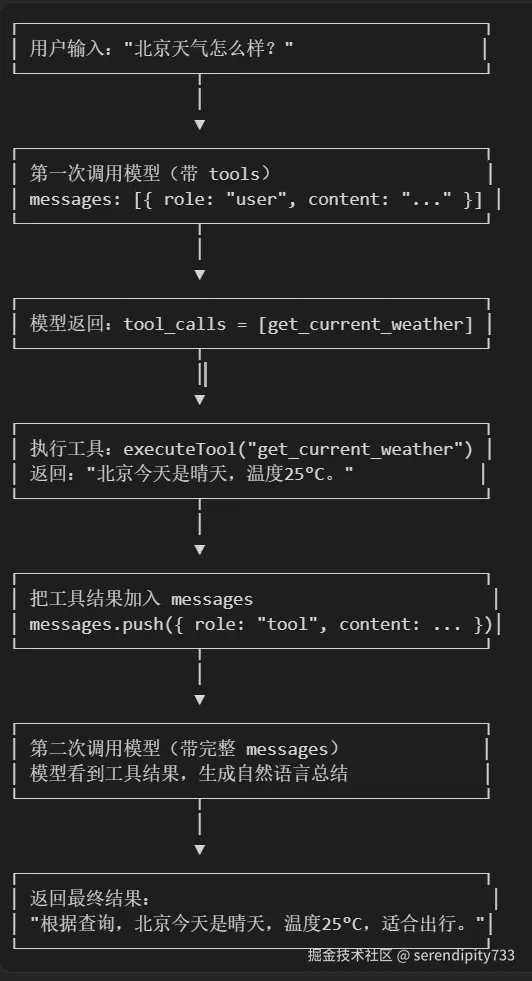
接口请求
js
router.post("/", async (req, res) => {
try {
const { message, model = "qwen-plus" } = req.body;
if (!message) {
return res.status(400).json({
success: false,
error: "message 参数不能为空",
});
}
console.log(`🤖 收到工具调用请求: ${message}`);
const result = await chatWithTools(message, model);
console.log(`✅ 工具调用完成,最终回复: ${result.finalResponse}`);
res.json({
success: true,
response: result.finalResponse,
needToolCall: result.needToolCall,
toolCallLogs: result.toolCallLogs || [],
model,
});
} catch (error) {
console.error("❌ 工具调用错误:", error);
res.status(500).json({
success: false,
error: error.message || "服务器内部错误",
});
}
});流式调用(单个工具)
注意: 工具函数名称仅在第一个流式返回的对象(delta) 中出现 核心设置:stream:true
函数
js
export const streamChatWithTools = async (
userMessage,
model = "qwen-plus",
{ onToken, onToolCall, onDone, onError } = {}
) => {
// 1. ----------------------发起请求---------------------------
const messages = [{ role: "user", content: userMessage }];
console.log("streamChatWithTools");
try {
while (true) {
const stream = await openai.chat.completions.create({
model,
messages,
tools,
stream: true,
});
// 单个工具调用
let toolCall = null; // 存储工具调用信息
let contentBuffer = ""; //累积文本内容
let finishReason = null; // 记录结束原因
//2.-------------逐块处理流式数据(目的就是拼接成完整信息)-------------------
for await (const chunk of stream) {
const choice = chunk.choices?.[0];
if (!choice) continue;
// 文本增量
const delta = choice.delta?.content || "";
console.log(choice.delta, "choice.delta");
if (delta) {
contentBuffer += delta;
onToken?.(delta);
}
// 工具调用增量(单个工具)
const deltaToolCalls = choice.delta?.tool_calls || [];
for (const tc of deltaToolCalls) {
// 🔴 第一次出现时初始化
if (!toolCall) {
toolCall = {
id: tc.id || "",
type: "function",
function: { name: "", arguments: "" },
};
}
// 🔴 累积拼接
if (tc.id) toolCall.id = tc.id;
if (tc.function?.name) toolCall.function.name += tc.function.name;
if (tc.function?.arguments) toolCall.function.arguments += tc.function.arguments;
}
// 结束原因
if (choice.finish_reason) {
finishReason = choice.finish_reason;
}
}
//3.--------------- 构造标准assistant 消息 ---------------------
const assistantMessage = {
role: "assistant",
content: contentBuffer || null,
};
if (toolCall && toolCall.id) {
assistantMessage.tool_calls = [toolCall]; // 🔴 单个工具也要用数组
}
messages.push(assistantMessage);
// 没有工具调用,流程结束
if (!toolCall || !toolCall.id) {
break;
}
// 执行单个工具
const funcName = toolCall.function.name;
const funcArgs = (() => {
try {
return JSON.parse(toolCall.function.arguments || "{}");
} catch {
return {};
}
})();
const result = await executeTool(funcName, funcArgs);
const resultStr = typeof result === "string" ? result : JSON.stringify(result);
onToolCall?.(funcName, funcArgs, resultStr);
// 🔴 添加工具消息
messages.push({
role: "tool",
tool_call_id: toolCall.id,
content: resultStr,
});
// 如果模型明确结束,不再继续
if (finishReason && finishReason !== "tool_calls") {
break;
}
}
onDone?.();
} catch (error) {
onError?.(error);
}
};代码逻辑
建议结合完整代码看 截个图放旁边最佳
处理流式数据
单工具调用时,无论返回了多少个chunk -->index 的值始终为0
chunk1(告诉你函数名,没返回任何文本信息 delta为空):
js
{
choices: [{
delta: {
role: "assistant",
tool_calls: [{
index: 0,
id: "call_abc123",
type: "function",
function: { name: "get_current_weather", arguments: "" }
}]
},
finish_reason: null
}]
}这个chunk可以知道deltaToolCalls
然后因为一开始toolCall是个null 所以要进行初始化 然后拼接
chunk2:
js
{
choices: [{
delta: {
tool_calls: [{
index: 0,
function: { arguments: "{\"location\":" }
}]
}
}]
}chunk3:
js
{
choices: [{
delta: {
tool_calls: [{
index: 0,
function: { arguments: "\"北京\"}" }
}]
},
finish_reason: "tool_calls"
}]
}拼接后 :
js
toolCall = {
id: "call_abc123",
type: "function",
function: {
name: "get_current_weather",
arguments: "{\"location\":\"北京\"}" // 完整的 JSON 字符串
}
}3.构造标准assistant信息
!!! toolCall 是有固定格式的
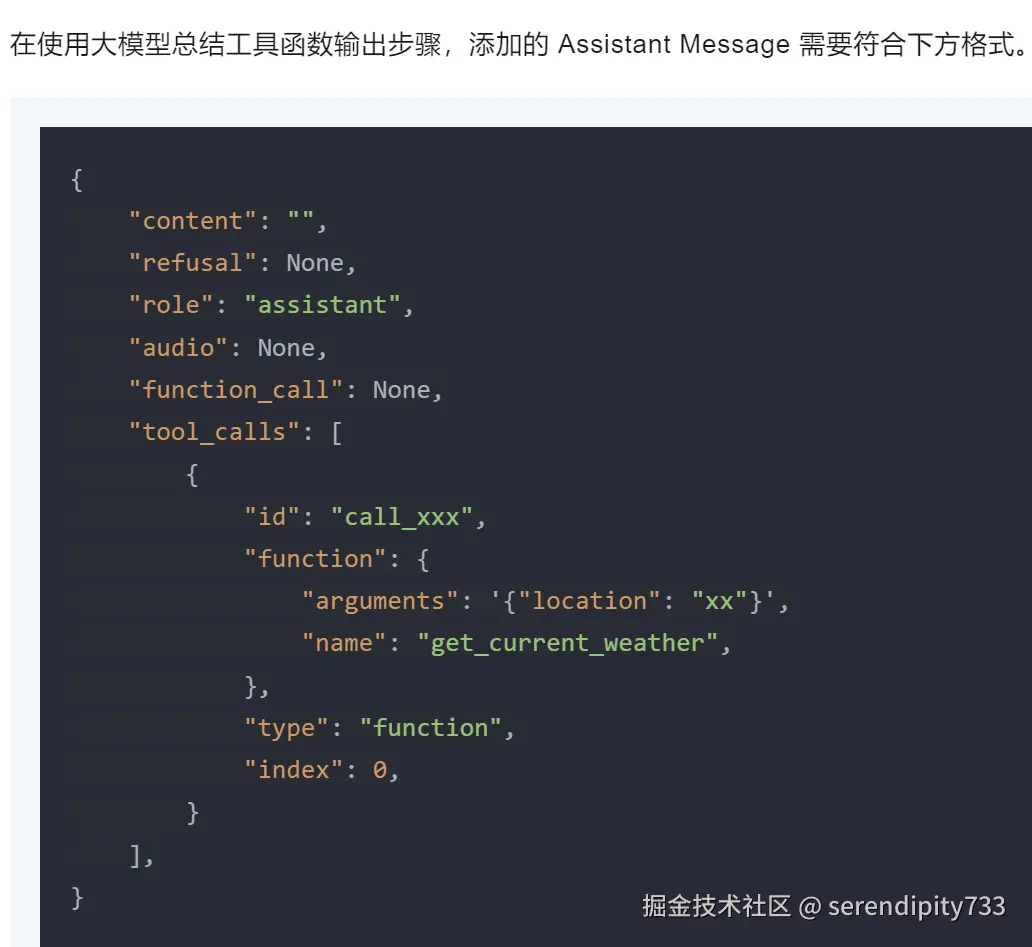
此时的message :
js
messages = [
{ role: "user", content: "北京天气怎么样?" },
{
role: "assistant",
content: null,
tool_calls: [{
id: "call_abc123",
type: "function",
function: {
name: "get_current_weather",
arguments: "{\"location\":\"北京\"}"
}
}]
}
]将工具信息添加到messages
此时的messages:
js
[
{ role: "user", content: "北京天气怎么样?" },
{
role: "assistant",
content: null,
tool_calls: [{ id: "call_abc123", ... }]
},
{
role: "tool",
tool_call_id: "call_abc123",
content: "{\"temperature\":15,\"weather\":\"晴天\"}"
}
]进入二次循环
再次循环调用AI 但这次messages包含了工具结果 AI看到工具结果后开始生成自然语言服务
这次delta有数据了 就开始调用onToken每次触发 前端可以逐字显示 最后的contentBuffer就是一个完整句子:"北京今天天气晴朗,温度15度。"
最终的messages:
js
messages = [
{ role: "user", content: "北京天气怎么样?" },
{ role: "assistant", content: null, tool_calls: [...] },
{ role: "tool", tool_call_id: "call_abc123", content: "{...}" },
{ role: "assistant", content: "北京今天天气晴朗,温度15度。" }
]循环结束 触发onDone 对话结束
流式调用(并行工具)
核心参数 parallel_tool_calls:true
并行工具实际上是为了支持询问多次
以北京上海天气为例
单个工具只会接收北京的天气 因为目前只能执行天气函数 location 是北京 并行工具就可以调用多次
函数
js
/**
* 流式工具调用(支持多工具并行)
* @param {string} userMessage - 用户消息
* @param {string} model - 模型名称
* @param {function} onToken - 文本增量回调 (delta: string) => void
* @param {function} onToolCall - 工具调用回调 (toolName, args, result) => void
* @param {function} onDone - 完成回调 () => void
* @param {function} onError - 错误回调 (error) => void
*/
export const streamChatWithTools = async (
userMessage,
model = "qwen-plus",
{ onToken, onToolCall, onDone, onError } = {}
) => {
const messages = [{ role: "user", content: userMessage }];
console.log("streamChatWithTools");
try {
// 可能发生多轮:模型产生 tool_calls -> 执行工具 -> 继续流式总结
while (true) {
const stream = await openai.chat.completions.create({
model,
messages,
tools,
tool_choice: "auto",
parallel_tool_calls: true, // 支持并行工具调用
stream: true,
});
// 聚合流式增量:按 index 累积 tool_calls
const toolCallsMap = new Map(); // 用来拼接工具调用的增量 index -> { id, type, function: { name, arguments } }
let contentBuffer = ""; //用来拼接文本的增量
let finishReason = null; // 用来记录结束原因
for await (const chunk of stream) {
// 工具函数名称:仅在第一个流式返回的对象(delta)中出现。
const choice = chunk.choices?.[0];
if (!choice) continue;
// 文本增量
const delta = choice.delta?.content || "";
console.log(choice.delta, "choice.delta");
if (delta) {
contentBuffer += delta;
onToken?.(delta);
}
// 工具调用增量(OpenAI 风格:按 index 累积)
const deltaToolCalls = choice.delta?.tool_calls || [];
for (const tc of deltaToolCalls) {
const idx = tc.index ?? 0;
// 先创建后赋值
// 如果是这个工具的第一次出现,初始化空对象
if (!toolCallsMap.has(idx)) {
toolCallsMap.set(idx, {
id: tc.id || "",
type: "function",
function: { name: "", arguments: "" },
});
}
// 获取当前工具的累积对象
const current = toolCallsMap.get(idx);
// 拼接 ID(通常只在第一个 chunk 有)
if (tc.id) current.id = tc.id;
// 拼接函数名(可能分多次推送:"get" + "_current" + "_weather")
if (tc.function?.name) current.function.name += tc.function.name;
// 拼接参数(JSON 字符串分多次推送:'{"loc' + 'ation":"北京"}')
if (tc.function?.arguments)
current.function.arguments += tc.function.arguments;
}
// 结束原因
if (choice.finish_reason) {
finishReason = choice.finish_reason;
}
}
// 本轮流式结束,若有内容则加入消息
const assistantMessage = {
role: "assistant",
content: contentBuffer || null,
};
const toolCalls = Array.from(toolCallsMap.values()).filter((tc) => tc.id);
if (toolCalls.length > 0) {
assistantMessage.tool_calls = toolCalls;
}
messages.push(assistantMessage);
// 没有工具调用,流程结束
if (toolCalls.length === 0) {
break;
}
// 并行执行所有工具
const toolMessages = await Promise.all(
toolCalls.map(async (tc) => {
const funcName = tc.function.name;
const funcArgs = (() => {
try {
return JSON.parse(tc.function.arguments || "{}");
} catch {
return {};
}
})();
const result = await executeTool(funcName, funcArgs);
const resultStr =
typeof result === "string" ? result : JSON.stringify(result);
// 通知前端工具调用结果
onToolCall?.(funcName, funcArgs, resultStr);
return {
role: "tool",
tool_call_id: tc.id,
content: resultStr,
};
})
);
// 批量加入工具消息
messages.push(...toolMessages);
// 如果模型明确 finish_reason !== 'tool_calls',不再继续
if (finishReason && finishReason !== "tool_calls") {
break;
}
}
onDone?.();
} catch (error) {
onError?.(error);
}
};这个我就不多说了 中间部分的实际上核心还是进行拼接 用map 数组都可以
然后使用Promise.all并行调用 拿到所有结果再给AI处理
官方的单(多)个工具通用的方法:
js
const toolCalls = {};
for await (const responseChunk of stream) {
const deltaToolCalls = responseChunk.choices[0]?.delta?.tool_calls;
if (deltaToolCalls) {
for (const toolCallChunk of deltaToolCalls) {
const index = toolCallChunk.index;
if (!toolCalls[index]) {
toolCalls[index] = { ...toolCallChunk };
if (!toolCalls[index].function) {
toolCalls[index].function = { name: '', arguments: '' };
}
}
else if (toolCallChunk.function?.arguments) {
toolCalls[index].function.arguments += toolCallChunk.function.arguments;
}
}
}
}